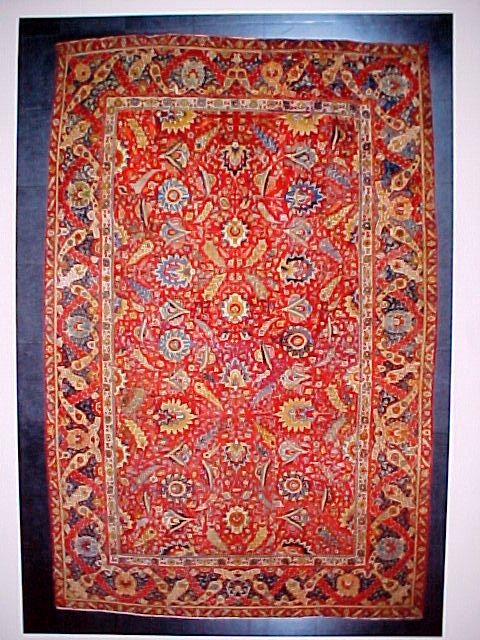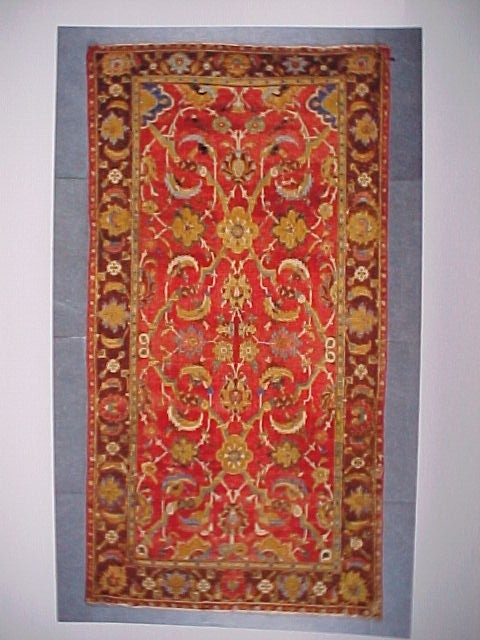SFBARS
A Wonderful Discovery
Curators at the Asian Art Museum recently made an astonishing
discovery--three 17th c. Moghul Indian carpets! The rugs had
belonged to Avery Brundage; he had used them in his home until
his death in 1975. These important carpets, which had been
stored away and forgotten for decades, only resurfaced when art
objects were being prepared to be moved from the Museum to the
Asian's new site at Civic Center.

(Curators Forrest McGill and Michael Knight)
The most important of the three carpet is surely one of the most beautiful
rugs in any museum. Although reduced in size, the carpet remains huge, measuring 11'7" in width and approximately 17' in length. Its design of spiky leaves and
resplendent blossoms in multiple tones of blues, rose red, greens
and golds covers a brilliant cherry red field. This carpet is remarkably
similar to a 17th c Indian carpet from Lahore (a gift of J. Pierpont Morgan) in the
Metropolitan Museum in New York, which measures 11'1" x 30'3". (See color plate facing fig 129 in Dimand and Mailey's
Oriental Rugs in the Metropolitan Museum of Art.
 The field design of these two carpets is nearly identical.
Not only is the overall composition virtually the same, but also
the drawing of individual leaves and blossoms. However, the
carpets have totally different borders. The Asian Arts carpet,
has a spectacular intertwining strap/leaf arabesque border while
the Metropolitan Museum rug has a more sedate cartouche
border, one which also appears on a similar Lahore carpet in the
Gulbenkian museum, Lisbon (see Hali 114, p80).
The field design of these two carpets is nearly identical.
Not only is the overall composition virtually the same, but also
the drawing of individual leaves and blossoms. However, the
carpets have totally different borders. The Asian Arts carpet,
has a spectacular intertwining strap/leaf arabesque border while
the Metropolitan Museum rug has a more sedate cartouche
border, one which also appears on a similar Lahore carpet in the
Gulbenkian museum, Lisbon (see Hali 114, p80).
These Lahore carpets share certain features commonly agreed to be
indicative of Indian manufacture: tone-on-tone color, usually without
separating outlines (for example light blue on dark blue, rose on
red, gold on yellow, etc.); a distinctive leaf design variously described
as wisteria or grape-like; and thirdly, warps consisting of 5-8 strands
rather than the 4 strands common to their Indo/Persian counterparts.
 The other two Asian Art carpets belong to the so-called "Indo/Persian"
class, a designation which indicates a long lasting controversy
as to the origin of rugs in this group. Throughout the 19th and 20th
centuries rugs of this class have variously been called Ispahan,
Indo-Ispahan, Indo-Persian, and Herat. Most auction house
experts, many dealers and some scholars are again calling them
"Ispahan" or "Isfahan." The Indo/Persian rugs constitute a cohesive
group, readily recognized by a distinctive crimson field and deep green
or dark blue border. Like their Lahore counterparts, "flaming" palmettes,
bi-colored leaves, and arabesques decorate the field. Borders are frequently
filled with blossoms flanked by two leaves, the so- called "Herati"
pattern.
The other two Asian Art carpets belong to the so-called "Indo/Persian"
class, a designation which indicates a long lasting controversy
as to the origin of rugs in this group. Throughout the 19th and 20th
centuries rugs of this class have variously been called Ispahan,
Indo-Ispahan, Indo-Persian, and Herat. Most auction house
experts, many dealers and some scholars are again calling them
"Ispahan" or "Isfahan." The Indo/Persian rugs constitute a cohesive
group, readily recognized by a distinctive crimson field and deep green
or dark blue border. Like their Lahore counterparts, "flaming" palmettes,
bi-colored leaves, and arabesques decorate the field. Borders are frequently
filled with blossoms flanked by two leaves, the so- called "Herati"
pattern.

Currently, scholars in America usually consider the Indo/Persian
group to have been woven in India. On the other hand experts in
Britain and Europe usually argue for a Persian provenance, the
assumption being, it seems, that if one group (the Lahores) is Indian,
then the Indo/Persians must be Persian--an argument that principally
rests on the their use of 4 ply weft as well as more subjective criteria
such as subtle color and design variations. Yet 4 ply wefts are certainly
not unknown in rugs designated as Indian.
(For a detailed discussion of the India vs Persian controversy,
see Murray Eiland's Chinese and Exotic Rugs)
One of the two Asian Arts Indo/Persian carpets has a rare diagonal
repeat compartment design similar not only to two well-known Isfahan
"Polonaise" carpets in Berlin but also to Kirman "vase" carpet compartment
designs. The third Asian Arts carpet has the more typical Indo/Persian
design--that of a field filled with palmettes and cloudbands.
These two rugs which are otherwise dissimilar share an unusual border
element of small white blossom-crosses separating the blossom/leaf
Herati pattern.
(For the Polonaise rugs see Fredrich Spuhler Oriental Carpets in the
Museum of Islamic Art, Berlin, pl 84. and 85. For a "vase" carpet
see figure 109 Dimand & Mailey)

Many Indian carpets have patterns similar to those of the Persian
"vase" Kirmans--for example shrub designs, compartment formats,
and blossom/sickle leaf designs. Like the Indo/Persian group, "vase"
Kirmans also frequently have crimson fields and dark blue borders. Based
on our knowledge of important trade patterns between Persia and India, we
may reasonably assume that the designs of both the Polonaise Isfahans and
Indian rugs derive in large part from the spectacular vase carpets of Kirman.
When the three Asian Arts carpets are seen together, it is
difficult for us to believe they came from such widely different areas
as Persia and India. Despite the slight difference in construction
(4 strand warp rather than 5-8), from the back, the weave of all three
rugs appears strikingly similar. Their use of colors and color
harmonies are the same--the golds, blues, greens, and shades of
crimson appear to originate from the same geographical area.
As some scholars have noted, Jose Ferrandis Torres'
1933 exposition catalogue Alfombras Antiguas Espanolas lists a
very large number of long, narrow rugs having crimson fields and
green borders specifically mentioned in early inventories as
coming from India--"una alfombra de la India de Portugal" (a carpet
from India coming from Portugal). It seems reasonable to assume
that the rugs mentioned by Torres are Indo/Persian a
conclusion evidenced by the large numbers of these 17th century
rugs still on view in museums and churches in Portugal and Spain.
Finally, especially significant is the fact that carpets from both groups
once owned by the Maharaja of Jaipur still retain labels identifying
their origin as Lahore. This fact would seem to definitively settle the
controversy. Thus we may regard the three Asian Arts carpets as
Moghul Indian rugs.
(see Murray Eiland p.150)
Whatever the provenance, however, they are a significant addition
to the Asian Art Museum's growing collection of Asian rugs.
Hillary Dumas
|

 The field design of these two carpets is nearly identical.
Not only is the overall composition virtually the same, but also
the drawing of individual leaves and blossoms. However, the
carpets have totally different borders. The Asian Arts carpet,
has a spectacular intertwining strap/leaf arabesque border while
the Metropolitan Museum rug has a more sedate cartouche
border, one which also appears on a similar Lahore carpet in the
Gulbenkian museum, Lisbon (see Hali 114, p80).
The field design of these two carpets is nearly identical.
Not only is the overall composition virtually the same, but also
the drawing of individual leaves and blossoms. However, the
carpets have totally different borders. The Asian Arts carpet,
has a spectacular intertwining strap/leaf arabesque border while
the Metropolitan Museum rug has a more sedate cartouche
border, one which also appears on a similar Lahore carpet in the
Gulbenkian museum, Lisbon (see Hali 114, p80). The other two Asian Art carpets belong to the so-called "Indo/Persian"
class, a designation which indicates a long lasting controversy
as to the origin of rugs in this group. Throughout the 19th and 20th
centuries rugs of this class have variously been called Ispahan,
Indo-Ispahan, Indo-Persian, and Herat. Most auction house
experts, many dealers and some scholars are again calling them
"Ispahan" or "Isfahan." The Indo/Persian rugs constitute a cohesive
group, readily recognized by a distinctive crimson field and deep green
or dark blue border. Like their Lahore counterparts, "flaming" palmettes,
bi-colored leaves, and arabesques decorate the field. Borders are frequently
filled with blossoms flanked by two leaves, the so- called "Herati"
pattern.
The other two Asian Art carpets belong to the so-called "Indo/Persian"
class, a designation which indicates a long lasting controversy
as to the origin of rugs in this group. Throughout the 19th and 20th
centuries rugs of this class have variously been called Ispahan,
Indo-Ispahan, Indo-Persian, and Herat. Most auction house
experts, many dealers and some scholars are again calling them
"Ispahan" or "Isfahan." The Indo/Persian rugs constitute a cohesive
group, readily recognized by a distinctive crimson field and deep green
or dark blue border. Like their Lahore counterparts, "flaming" palmettes,
bi-colored leaves, and arabesques decorate the field. Borders are frequently
filled with blossoms flanked by two leaves, the so- called "Herati"
pattern. 
